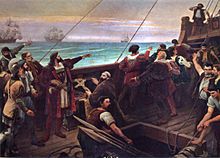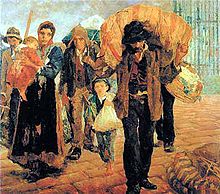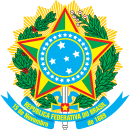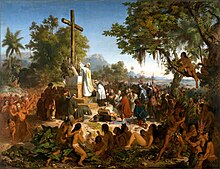Brazilian painting



| Part of a series on the |
| Culture of Brazil |
|---|
 |
| Society |
|
| Topics |
|
| Symbols |
Brazilian painting, or visual arts, emerged in the late 16th century, influenced by the Baroque style imported from Portugal. Until the beginning of the 19th century, that style was the dominant school of painting in Brazil, flourishing across the whole of the settled territories, mainly along the coast but also in important inland centers like Minas Gerais.
A sudden break with the Baroque tradition was imposed on the art of the nation by the arrival of the Portuguese court in 1808, fleeing the French invasion of Portugal. However, Baroque painting still survived in many places until the end of the 19th century. In 1816, the king, John VI, supported the project of creating a national Academy at the suggestion of some French artists led by Joachim Lebreton, a group later known as the French Artistic Mission. They were instrumental in introducing the Neoclassical style and a new concept of artistic education mirroring the European academies, being the first teachers at the newly founded school of art.
Through the following 70 years, the Royal School of Sciences, Arts and Crafts, later renamed the
In 1889 the monarchy was abolished, and the republican government renamed the Imperial Academy the National School of the Fine Arts, which would be short-lived, absorbed in 1931 by the
The period between 1950 and 1970 witnessed the emergence of many new styles.
History
Before the Portuguese discovery

Relatively little is known in respect to the pictorial art practiced in Brazil before the Portuguese discovery of the territory. The
These paintings probably had ritual functions and would have been seen as endowed with magical powers, capable of capturing the souls of depicted animals and therefore allowing for successful hunts. The most ancient complex of sites known is that of the
Precursors


Among the first explorers of the newly discovered land came artists and naturalists, charged with making a visual register of the flora, fauna, geography and native peoples, working only with
Such output from the travelers still displayed features of late
Pernambuco and the Dutch
The first Brazilian cultural nucleus that resembled a European court was founded in
The flourishing Baroque
Between the 17th and 18th Centuries the Brazilian painting style was the
The Brazilian Baroque was formed through a complex fabric of European and local influences, although generally colored by the Portuguese interpretation of the style. The context in which the Baroque developed in the colony was completely different from its European origins. Here, the environment was one of poverty and scarcity, with everything yet to be done,[7] and contrary to Europe, within the immense colony of Brazil, there was no court, the local administration was inefficient and sluggish, opening a vast performance space for the Church and its missionary battalions, who administered in addition to divine services, a series of civil services such as issuance of birth and death certificates. They were on the vanguard of conquest of the interior of the territory, serving as evangelists and pacifiers to indigenous populations.
Gallery
-
Ricardo do Pilar: The man of sorrows, 17th century
-
João Nepomuceno Correia e Castro: The Immaculate Conception, 18th century
-
Manuel de Jesus Pinto: St. Peter receiving the keys of the Church, c. 1804 – 1815.
-
Manuel da Costa Ataíde: Our Lady surrounded by musician angels, early 19th century.
-
Simplício de Sá: Portrait of emperor Peter I, ca. 1830.
-
Agostinho José da Mota: Still-life, 1860
-
Victor Meirelles: Moema, 1866.
-
Pedro Américo: Battle of Avaí, 1872-77.
-
Georg Grimm: Icaraí, 1884
-
Almeida Junior: Model's rest, 1882.
-
Belmiro de Almeida: Effects of sunlight, 1893
-
Manuel Lopes Rodrigues: Alegory of the Republic, 1896.
-
Jerônimo José Telles Júnior: Wind storm, 1902
-
Antônio Parreiras: Sorrowful, 1909
-
Ismael Nery: Nude woman crouching.
-
Ado Malagoli: The black cat, ca. 1950.
-
Geraldo Trindade Leal: Ginete, 1951.
-
Jader Siqueira: Triptych, 1977
-
Carlos Carrion de Britto Velho: Painting #2, 1977.
-
Milton Kurtz: Quasi contacto, 1989.
See also
- Visual arts
- Brazilian culture
- Brazilian art
- Brazilian Romanticism painting
References
- ^ Louzada, Maria Alice & Louzada, Julio. Os Primeiros Momentos da Arte Brasileira Archived July 6, 2011, at the Wayback Machine. Júlio Louzada Artes Plásticas Brasil. Acesso 5 out 2010
- ^ Leite, José Roberto Teixeira & Lemos, Carlos A.C. Os Primeiros Cem Anos, in Civita, Victor. Arte no Brasil. São Paulo: Abril Cultural, 1979
- ^ Fernandes, Cybele Vidal Neto. Labor e arte, registros e memórias. O fazer artístico no espaço luso-brasileiro. IN Actas do VII Colóquio Luso-Brasileiro de História da Arte. Porto: Universidade do Porto/CEPESE/FCT, 2007. p. 111
- ^ Gouvêa, Fernando da Cruz. Maurício de Nassau e o Brasil Holandês. Editora Universitária UFPE, 1998. pp. 143-149; 186-188
- ^ Costa, Maria Cristina Castilho. A imagem da mulher: um estudo de arte brasileira. Senac, 2002. pp. 55-56
- ^ Sevcenko, Nicolau. Pindorama revisitada: cultura e sociedade em tempos de virada. Série Brasil cidadão. Editora Peirópolis, 2000. pp. 39-47
- ISBN 9788587864222. Retrieved 2015-09-10.




















